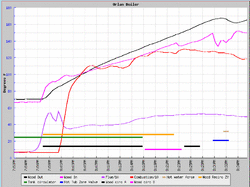I have been burning the new tarm for a couple weeks now and am still learning how to tune the fire. This past weekend I made some fires with some wood that had seasoned for 2+ years with a small roof over it, as opposed to about 1 year old wood that was in the open. The older wood burned WAY hotter. The gasification was so intense that it almost made me nervous. I almost though the Tarm was going to lift off.
Is it possible to have a flame that is too intense? I was able to remove heat by charging the tank but the temp on the tarm control panel was right at 90*C (194*), which is right about where the fan turns off.
Also, what is the best setting for the 2ndary inlet? If I open it all the way I get almost invisible flame, but very strong blowing, like a jet, with lots of burning embers blowing through. If I close it all the way I get a huge bilowing orangish bluish flame that extends out of the front of the tunnel and bends back a bit toward the rear of the boiler.
What is the description of the perfect flame?
Is it possible to have a flame that is too intense? I was able to remove heat by charging the tank but the temp on the tarm control panel was right at 90*C (194*), which is right about where the fan turns off.
Also, what is the best setting for the 2ndary inlet? If I open it all the way I get almost invisible flame, but very strong blowing, like a jet, with lots of burning embers blowing through. If I close it all the way I get a huge bilowing orangish bluish flame that extends out of the front of the tunnel and bends back a bit toward the rear of the boiler.
What is the description of the perfect flame?



